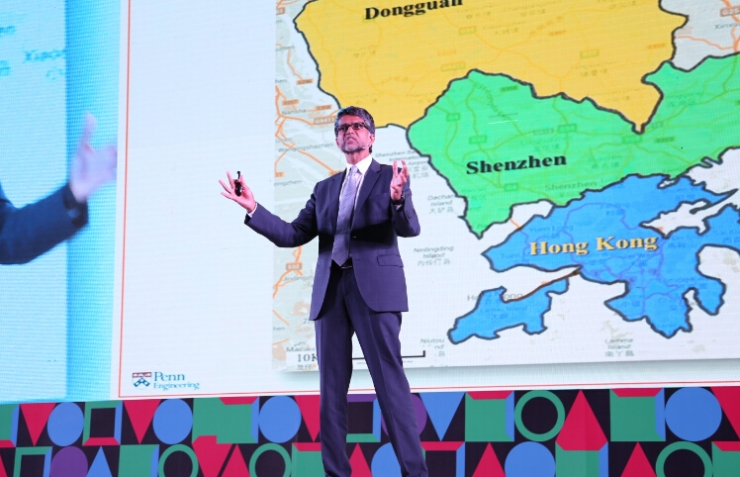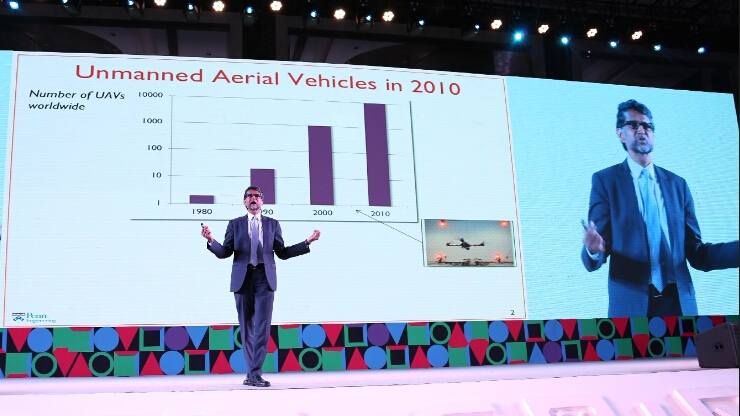
Vijay Kumar is the Dean of the University of Pennsylvania School of Engineering and a member of the U.S. National Academy of Engineering. His main research direction is the control and collaboration of multi-robot formations. He is also known as the drone god. If you read his speech on TED, he will certainly be impressed by the drones he developed.
On the afternoon of August 13 , Kumar attended the CCF-GAIR Summit organized by the Chinese Computer Society and organized by Lei Feng. He also delivered a speech on the five major development trends of drones. He believes that there is no opportunity for the development of trends such as Small, Safe, Smart, Speed, and S warm.
Before the speech, Kumar also had a dialogue with Lei Feng Net about what was the intelligence of drones, his vision for drones, and his thoughts behind the fleet.
Data is not knowledge, calculations are not intelligent
In Kumar's view, the overall development trend of UAVs in the future is "Atonomy". Looking back at the past five years, the increase in computing power, data, and communication technology has led to the development of AI (artificial intelligence) technology, which has also made autonomous drones more autonomous and intelligent. Specifically, the drone's size has become smaller, and its perceived ability and range (due to radar) have increased.
He believes that autonomy is a cycle from perception to action . From seeing the environment, processing information, understanding the environment, and then taking action, this rapid cycle is smart. In his research, "AI is data and computation."
But at the same time drones also face challenges, Kumar believes, this mainly includes two aspects:
"More data does not mean more knowledge; faster calculations also do not mean autonomous. "
Using AI techniques such as machine learning can improve the performance of the algorithm and achieve autonomous drones, just as there is mutual interference in the cluster. Machine learning can ensure safety and stability; and the data collected by the machine can be fed back to machine learning algorithms. What we need to do is to turn efficiently collected data into knowledge. And although machine learning has made AI progress, accuracy is still not enough, such as object recognition, even if there is a lot of data training. So what we should think about is how to coexist in life with less precise and reliable technology.
Drone Express is missing business model
Google and Amazon have their own drone express project Project Wing and Prime Air, domestic Jingdong and SF have also tested drone delivery. However, as the originator of aerial robots, Kumar believes that the use of drone delivery also lacks commercial value.
He told Lei Feng that there are two types of innovation: one is technological innovation, and the other is commercial innovation. Technological innovation is relatively uncomplicated. The laboratory he supervised started delivering delivery drones five years ago, which is earlier than Google and Amazon. The delivery drone involves the cooperation of the fleet, and this is exactly what he is good at.
However, he believes that the delivery drone does not currently have a good business model . If Uber has the same pattern as DDT, it may be more likely to be popularized. His job is to develop related technologies for future use. .

Drone group
Nature will often provide us with technical inspiration. For example, the aircraft that was invented at the beginning of the last century was inspired by the birds. The laboratory is also very good at Kumar's how to observe nature to solve the problem.
In his speech, he mentioned the "5S" of drones, where "Swarm" refers to the fleet. One of the costs of miniaturization is that the load becomes smaller, and the tasks that can be accomplished are then reduced. For this reason, they get inspiration from the way the bee colony works, allowing multiple drones to collaborate and complete tasks that individuals cannot perform. There are three principles for organizing the fleet:
First, individuals act independently and actions are local and independent;
The second is that you only need local information to act. Even if you do not know global information, individuals can act.
Finally, it is anonymous in action, independent of identity, and can accomplish tasks without knowing individual information. The example he gives here is that when many people raise a table together, they do not need to know each person's identity.
The drone shipment mentioned above involves the application of the fleet. During the Spring Festival and the peak period of delivery of the Double Nine, drones in certain areas need to cooperate with each other when they avoid similar obstacles. Kumar also quoted another example of the exchange with domestic scholars on the CCF-GAIR, that is, using the drone to draw the Great Wall map, which is obviously a single drone can not do.
In addition, we live in a connected world. Now that these devices are fixed, but will move in the future, how to make millions of devices collaborate, which requires bee colony theory.
Autonomous aircraft will come faster than self-driving cars
Flight has always been a human dream. Although the airplane has become a popular way of travel, it still lacks the freedom of a car. With the advancement of companies such as Google and Tesla, it seems that self-driving cars can make people feel smarter in the future. But Kumar believes that "self-flying vehicles (drones) will be easier to achieve than self-driving cars . " because:
"Automotive vehicles need to operate in a very complex two-dimensional road environment, but the aircraft can fly in 3D space. The route can be determined by the electronic system. For example, from Shenzhen to Hong Kong, a route can be defined in the air to ensure that collisions will not occur, and This does not require any infrastructure like a road."
He told Lei Fengwang that many night-time flight missions still require people to be present, but in fact people only act according to the instructions of the machine. So why not let the machine do everything?
One of the challenges of this kind of aircraft is the energy consumption. A person who takes an ordinary 50kg will consume a lot of power. One solution is to use fuels such as gasoline or diesel, but this requires a different drive system. But Kumar believes that "small autonomous vehicles, such as flying cars, have existed for a long time and are now becoming more realistic."
"Aerial photography is the application scenario that I think of at the end."
Today's consumer-class drone market is almost exclusively owned by DJI, and the application is nothing more than aerial photography. What other application scenarios can generate commercial value? Kumar's response to this is, "If I know how to make money, there must be other companies already doing it." He told Lei Fengwang that his job is to "develop solutions so that a viable business model will emerge in the next five years." There is technology available."
However, his greatest interest is the use of drones in first aid and agriculture. He hopes that the robot will be able to rush to the scene the first time when a disaster occurs. It will quickly return real-time information, just like Superman, and aerial photography will be the last thing he will think of. Scenes. The robotics field has "3D", which allows it to perform Dirty, Dull, and Dangerous work. The same applies to drones.
As far back as TED 2012, Kumar put forward "precision farming". He thinks that just as human beings are taken care of by doctors individually, planting can be done in the same way. For example, drones can be equipped with remote sensors, such as cameras, laser scanners, microwave image sensors, etc., to identify the growth status and yield information of each fruit tree, in order to estimate the overall production capacity and increase planting efficiency. Especially in countries with few people in the United States (only 3% of them are engaged in agriculture), machines will have greater value.
Similarly, Kumar pointed out that precision agriculture is feasible but still requires a realistic business model. For example, in Japan where farmland is small, the role of drone agriculture is limited. There are also policy issues such as government subsidies that prevent farmers from having incentives to increase planting efficiency.
Shenzhen is an innovative place for drones
The foreign guests' washing of domestic innovation is a highlight of this CCF-GAIR. During a group visit, a friend asked how much the gap between U.S. and U.S. drones was. Kumar said that “DJI in the commercial drone field is the most advancedâ€. The famous American investor Yobie Benjamin also said in his speech, "Do not listen to those who say that China will only plagiarize."
Kumar is coming to China for the third time. He believes that Shenzhen is not just about innovation in manufacturing. Its ecology is also very important for robots and it is a place of innovation for drones. There is also Tencent, whose WeChat products are the target of companies such as Facebook.
"In the United States, I may have a clever student to solve a problem, but in China there will be 100 engineers to solve the same problem. I can't compete."
He believes that innovation comes from talented people. It is not a person but a team. Shenzhen has such conditions. Technological innovation will not be limited to a certain region. It is global.
It is difficult to predict the future. In an exclusive interview, Kumar told Lei Fengwang (searching for the "Lei Feng Net" public concern) that "the progress of technology has been a great deal , which makes it difficult for us to draw conclusions." But this does not prevent us from imagining the future. Finally we send Kumar's two predictions on the robot.
What will happen to a cell phone after five years? He thinks it will become a robot. Now everything you have to do can be done in the future with a smarter smartphone. The mobile phone is placed on the motion controller and may become a robot.
In addition, in the 50-year history of the robot, we have already let the robot move. Now it can fly. How long can we learn to swim? To know that 70% of the Earth's surface is the ocean. As the population grows, underwater agriculture and underwater planting also provide economic drivers for corresponding robot development. However, the challenge here is how to let the robot learn to swim and how to solve underwater communication problems.
Recommended reading:
Father of aerial robot Vijay Kumar: Rome was not built in one day
Vijay Kumar of Pennsylvania: "5s" Trends and Challenges of UAVs